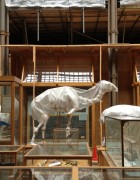The place of artefacts in design, in research, and in design research is a widely discussed and somewhat confusing one. As I continue to think about my third case study through the filter of the work I’ve already done with comics and network models, I wonder how to conceptualise the place of the research artefact in the wider context of my own practice. Avenier, Miettinen, and Rosa (2014) describe three angles for arriving at artefacts: the semiotic, the cultural historical, and the design scientific. The semiotic perspective is all about meaning making and an analysis of artefacts as ‘tools to direct action’. So the artefact directs action and is seen as what Van Leeuwen (see post of October 30 2013) would call a semiotic resource and a form of social representation. How then to analyse the resulting actions the artefact gives rise to? Can there ever be a semiosis of behaviour? How would the text be captured or codfied?
The cultural historical view of artefacts has been taken up in HCI in the reified form of activity theory. This looks back to social psychology and Lev Vygotsky and frames the artefact as a mediating entity. Where it gets confusing is that activity theory considers ideas, theories, language, signs, symbols, and concepts to be artefacts that mediate how people progress towards their goals according to their motivations. Social structure itself can be an artefact. Where then are the limits of the artefact? How can we describe the network of interactions the artefact mediates? How do we account for intersecting artefacts where they all mediate different facets of the same action? The density and complexity of activity theory is one reason why it has fallen out of favour in HCI research.
The design science view of artefacts is an interesting one (if somewhat misnamed in my view). It uses a definition from Herbert Simon of artefacts that looks illuminating. Artefacts are defined as ‘systems shaped by human intentions to be integrated in an identified context’. They have two essential properties: goal directness, and contingency to context. So, how does the researcher direct or define the goals of the participants? and how well are those goals fulfilled? My intention has always been to design an open and flexible situation (in the Dewey sense) where the exercise is constrained but allows for creative flourishing. Design science places attention directly on the function, implementation, history and evolution of artefacts themselves. It takes the artefact as a subject of inquiry rather than a medium. Not so useful for me, but I still like that definition.
In design research, artefacts are seen as objects that are used in the process of doing design. The prototype is the clearest example. Dix et al (2008) consider the role of artefacts in mediated communication, Paavola and Hakkarainen (2009) propose the idea of trialogical – meaning person/person/artefact – designs as a way of thinking about how people use computers to learn things. There is no end of research on these topics. I like how Bodker (2009) describes three categories of artefacts deployed in user centred design. Verbal artefacts are instructions, prompts, questions etc. used by the researcher in dialogue with participants. Institutional artefacts are non-textual and consist of the range of assumptions and practices that influence ‘the background relationship’ between researchers and participants. Material artefacts are tangible objects such as pens, paper, wood, string that might be used to generate ideas or elicit responses. I like the way this classification allows for the way different types of artefacts overlap and influence each other.
For my work, the design of the research artefact is seen as practice in the same way a product-designer designs furniture. Attention is placed on the generation of the artefact not only as a mediating device or instrument to elicit responses (although these uses are included) but also as an expressive medium in its own right. In this way there is a very explicit process by which the research artefact comes onto being. It isn’t simply a case of picking up some post-it notes and a white board on the way to the workshop. Participants are invited to act through the artefact which consists of a whole arrangement of institutional and socio-cultural things, a careful configuration of artefactual circumstances.

